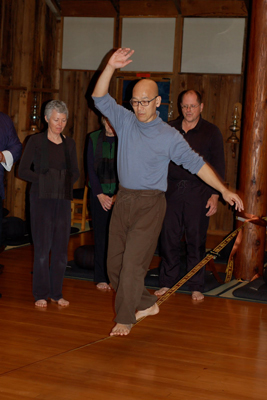Hey Mark, how did you reach the lotus position? I can barely do half-lotus and how good I do it is a matter of question. I did notice however, that meditation quality is increased with half-lotus compared to good old cross-legged.
I started out cross-legged, too. I agree, it’s better with the knees on the ground.
I’ve been sitting first thing in the morning and last thing at night for a long time, mostly forty minutes at a stretch, and mostly in the half-lotus.
About twenty years ago, I discovered I could “lay hold” of “one-pointedness”:
Herein… making self-surrender the object of (one’s) thought, (one) lays hold of concentration, lays hold of one-pointedness.
(SN v 198, Pali Text Society vol V p 174; parenthetical material paraphrases original)
Here’s my description of “one-pointedness”:
The presence of mind can utilize the location of attention to maintain the balance of the body and coordinate activity in the movement of breath, without a particularly conscious effort to do so. There can also come a moment when the movement of breath necessitates the placement of attention at a certain location in the body, or at a series of locations, with the ability to remain awake as the location of attention shifts retained through the exercise of presence.
There’s a frailty in the structure of the lower spine, and the movement of breath can place the point of awareness in such a fashion as to engage a mechanism of support for the spine, often in stages.
(Shunryu Suzuki on Shikantaza and the Theravadin Stages)
After about a decade of practice with that, I was able to sit the lotus during my practice periods. I was even able to sit a five-day sesshin at a local Zen center, mostly in the lotus.
I sat the lotus for a year or two after the sesshin, then I went back to sitting half-lotus, and I cut my periods back to 25 minutes. I had begun to feel pain in my knees–not when I sat, but afterwards, when I went out walking.
Fast-forward to the present, and I’m sitting on beyond 25 minutes a lot. My knees are fine, so long as I find my way to a particular feeling:
When the location of attention can shift anywhere in the body as a function of the movement of breath, and the activity of the body in inhalation and exhalation follows solely from the location of attention, there is a feeling of freedom.
(What Shunryu Suzuki Actually Said)
Even so, I don’t anticipate a return to the lotus anytime soon.
Here’s a picture of Issho Fujita demonstrating “one-pointedness” at the Sonoma Mountain Zen Center:

Here’s Gautama, speaking about intervals of practice that can “develop mindfulness of death acutely”—the intervals are moments that call for a presence of mind with the placement of attention:
…whoever develops mindfulness of death, thinking, ‘O, that I might live for the interval that it takes to swallow having chewed up one morsel of food… for the interval that it takes to breathe out after breathing in, or to breathe in after breathing out, that I might attend to the Blessed One’s instructions. I would have accomplished a great deal’ — they are said to dwell heedfully. They develop mindfulness of death acutely…
(AN 6.19 PTS: A iii 303 p 218; Maranassati Sutta: Mindfulness of Death (1) tr Thanissaro Bhikkhu; “effluents” rendered as “cankers” in the PTS translation by F. L. Woodward)
I can say that in the last year or so, my effort has changed:
I practice now to experience the free placement of attention as the sole source of activity in the body in the movement of breath, and in my “complicated, difficult” daily life, I look for the mindfulness that allows me to touch on that freedom.
Best of luck with your practice, Elysium.


